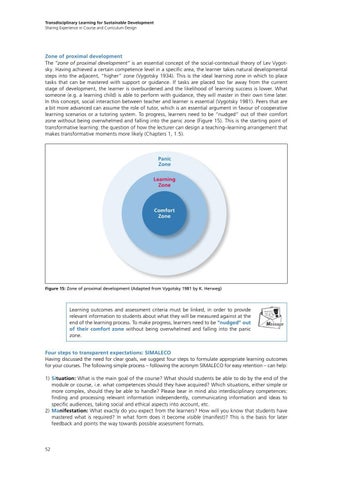Transdisciplinary Learning for Sustainable Development Sharing Experience in Course and Curriculum Design
Zone of proximal development The “zone of proximal development” is an essential concept of the social-contextual theory of Lev Vygotsky. Having achieved a certain competence level in a specific area, the learner takes natural developmental steps into the adjacent, “higher” zone (Vygotsky 1934). This is the ideal learning zone in which to place tasks that can be mastered with support or guidance. If tasks are placed too far away from the current stage of development, the learner is overburdened and the likelihood of learning success is lower. What someone (e.g. a learning child) is able to perform with guidance, they will master in their own time later. In this concept, social interaction between teacher and learner is essential (Vygotsky 1981). Peers that are a bit more advanced can assume the role of tutor, which is an essential argument in favour of cooperative learning scenarios or a tutoring system. To progress, learners need to be “nudged” out of their comfort zone without being overwhelmed and falling into the panic zone (Figure 15). This is the starting point of transformative learning: the question of how the lecturer can design a teaching–learning arrangement that makes transformative moments more likely (Chapters 1, 1.5).
Panic Zone Learning Zone
Comfort Zone
Figure 15: Zone of proximal development (Adapted from Vygotsky 1981 by K. Herweg)
Learning outcomes and assessment criteria must be linked, in order to provide relevant information to students about what they will be measured against at the end of the learning process. To make progress, learners need to be “nudged” out of their comfort zone without being overwhelmed and falling into the panic zone. Four steps to transparent expectations: SIMALECO Having discussed the need for clear goals, we suggest four steps to formulate appropriate learning outcomes for your courses. The following simple process – following the acronym SIMALECO for easy retention – can help: 1) Situation: What is the main goal of the course? What should students be able to do by the end of the module or course, i.e. what competences should they have acquired? Which situations, either simple or more complex, should they be able to handle? Please bear in mind also interdisciplinary competences: finding and processing relevant information independently, communicating information and ideas to specific audiences, taking social and ethical aspects into account, etc. 2) Manifestation: What exactly do you expect from the learners? How will you know that students have mastered what is required? In what form does it become visible (manifest)? This is the basis for later feedback and points the way towards possible assessment formats.
52














